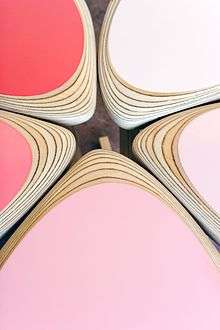Milk paint
Milk paint is a nontoxic water-based paint. It can be made from milk and lime, generally with pigments added for color.[1][2][3] In other recipes, borax is mixed with milk's casein protein in order to activate the casein and as a preservative.[4][5]

Milk paint has been used for thousands of years. It is extremely durable, often lasting for hundreds of years if protected from the elements. It is made of all-natural ingredients, and is very safe and non-toxic once applied. Because oil base and acrylic paints are made in vast quantities using cheap petrochemicals, their price can be low relative to the price of milk paint, which is sold in small quantities. Another impediment to using milk paint for some is that it does not come pre-mixed.[6] Milk paint is commonly sold in the powder form, which is a combination of casein and lime. Once water is added, the lime activates the casein and yields a durable but caustic paint, that can only be used on porous surfaces.
Before the invention of acrylics, most house paints were made from casein. There is a vast number of historical production documents that outline the manufacture of milk paint on an industrial scale. [7] This type of manufacturing is being revived on a small scale, so that the advantages of an all natural paint can be combined with the convenience of a ready made paint that requires no mixing.
Milk paint made from the borax casein recipe keeps for six months or more, if sealed very tightly to retain the moisture. With time, however, the casein binder will break down. Once lime casein milk paint has been mixed, it must be used within a day, or a little longer if refrigerated.[8]
Uses
Milk paint can be used to create authentic reproductions and replicas of antique furniture, or modern pieces that do not rely on any connection with the past.[9]
See also
- Casein paint
- Painting and the environment
References
- Beecher, Henry Ward (1859). Plain and pleasant talk about fruits, flowers and farming. Harvard University: Derby & Jackson. p. 187.
Milk paint.
- Transvaal (Colony). Dept. of Agriculture, Transvaal (South Africa). Dept. of Agriculture (1906). The Transvaal agricultural journal, Volume 4. University of California: Transvaal (Colony). Dept. of Agriculture, Transvaal (South Africa). Dept. of Agriculture. p. 876.
- Baird, Henry Carey (1867). The painter, gilder, and varnisher's companion: containing rules and regulations in every thing relating to the arts of painting, gilding, varnishing and glass-staining. Numerous useful and valuable receipts ... (10th ed.). Philadelphia/University of Wisconsin - Madison: Henry Carey Baird. p. 97.
- PS42 (Feb 1942). Magic of chemurgy duplicated in the home laboratory. Popular Science. p. 199.
- Wailes, Raymond B. (March 1940). How is it Made. Popular Science. p. 209.
- Staff. "A BRIEF HISTORY OF MILK PAINT" (web). The Old Fashioned Milk Paint Co., Inc. Retrieved 24 October 2009.
- Robert., Scherer (2010). Casein : its preparation and technical utilisation. Nabu Press. ISBN 9781178313543. OCLC 944390964.
- Brown; Joe Hurst-Wajszczuk; Del Brown (2006). Furniture You Can Build: Projects That Hone Your Skills. Taunton Press. p. 52. ISBN 1-56158-796-6.
Milk paint spoil.
- Terri McGraw Additional Tips: Milk Paint Prime Painting Tips Tuesday, September 29, 2009 Central Florida News 13